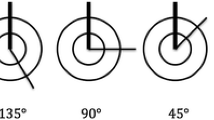Abstract
This study was designed to determine how changes in oxygen uptake (O2) and heart rate (HR) during submaximal cycle ergometry were determined by changes in cycle geometry and/or lower-limb kinematics. Fourteen trained cyclists [Mean (SD): age, 25.5 (6.4) years; body mass 74.4 (8.8) kg; peak O2, 4.76 (0.79) l. min−1 peak] were tested at three seat-tube angles (70°, 80°, 90°) at each of three trunk angles (10°, 20°, 30°) using a modified Monark cycle ergometer. All conditions were tested at a power output corresponding to 95% of the O2 at each subject's ventilatory threshold while pedalling at 90 rpm and using aerodynamic handlebars. Sagittal-view kinematics for the hip, knee, and ankle joints were also recorded for all conditions and for the subjects' preferred positioning on their own bicycles. No combination of seat-tube and trunk angle could be considered optimal since many of the nine conditions elicited statistically similar mean O2 and HR values. Mean hip angle (HA) was the only kinematic variable that changed consistently across conditions. A regression relationship was not observed between mean O2 or HR and mean hip angle values (P > 0.45). Significant curvilinear relationships were observed, however, between ΔO2 (O2 − minimum O2) and ΔHA (mean HA − preferred HA) using the data from all subjects (R = 0.45, SEE = 0.13 l . min−1) and using group mean values (R = 0.93, SEE = 0.03 l . min−1). In both cases ΔO2 minimized at ΔHA = 0, which corresponded to the subjects' preferred HA from their own bicycles. Thus, subjects optimized their O2 cost at cycle geometries that elicited similar lower-limb kinematics as the preferred geometries from their own bicycles.
Similar content being viewed by others
Author information
Authors and Affiliations
Additional information
Accepted: 3 July 1996
Rights and permissions
About this article
Cite this article
Heil, D., Derrick, T. & Whittlesey, S. The relationship between preferred and optimal positioning during submaximal cycle ergometry. Eur J Appl Physiol 75, 160–165 (1997). https://doi.org/10.1007/s004210050141
Issue Date:
DOI: https://doi.org/10.1007/s004210050141




